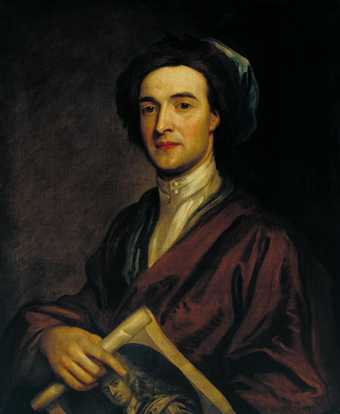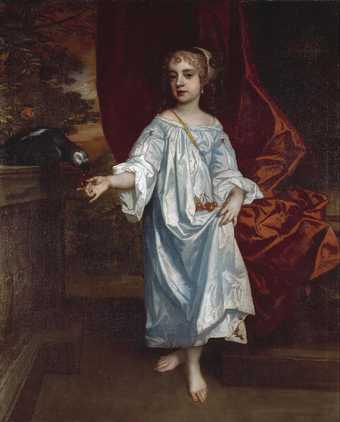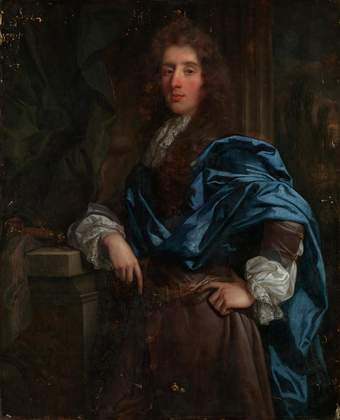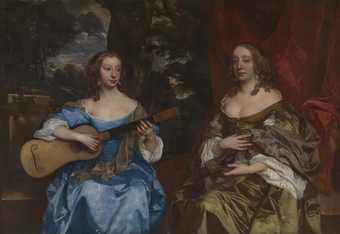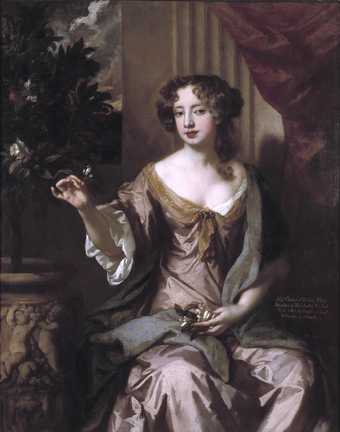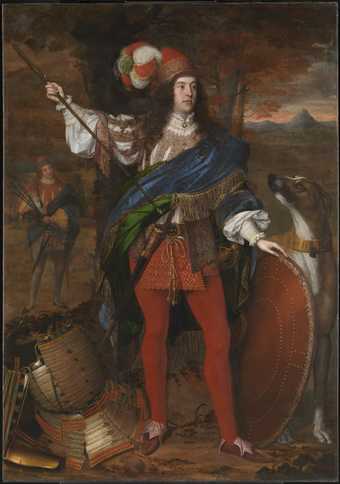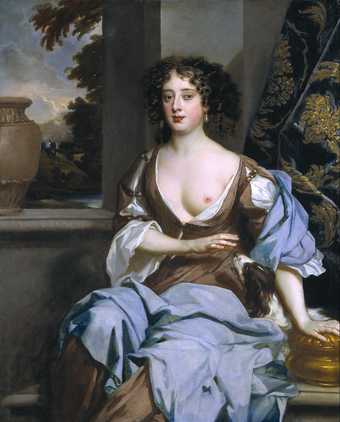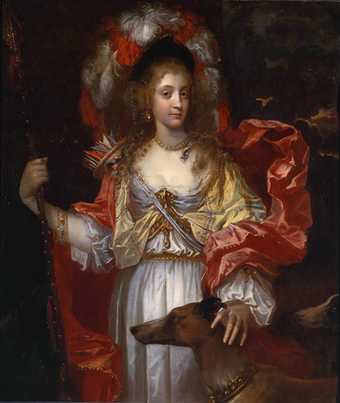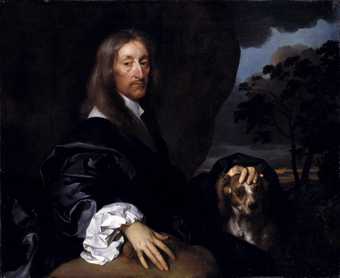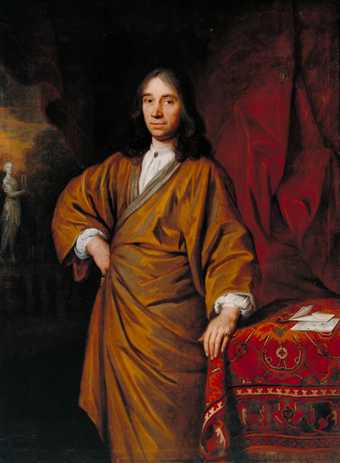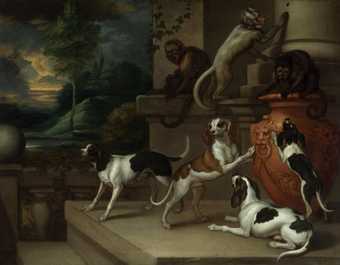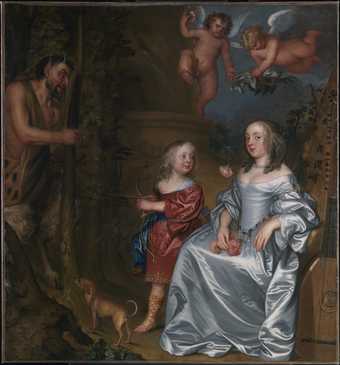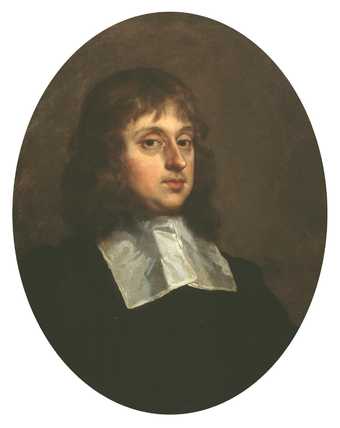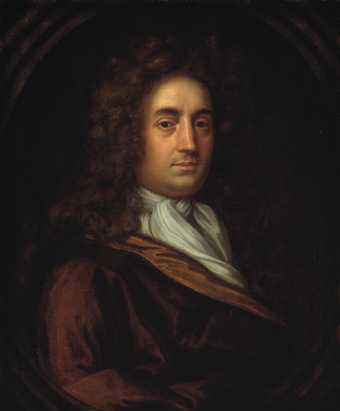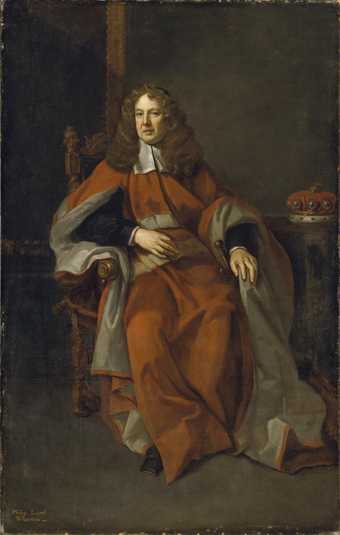
Not on display
- Artist
- Gilbert Soest c.1605–1681
- Medium
- Oil paint on canvas
- Dimensions
- Support: 1270 × 1073 mm
frame: 1447 × 1236 × 100 mm - Collection
- Tate
- Acquisition
- Purchased 1965
- Reference
- T00746
Summary
Henry Howard (1628-84) was the grandson of Thomas Howard, 14th Earl of Arundel (1585-1646) who had been the foremost collector and patron of the arts in Britain - apart from Charles I himself (reigned 1625-49) - in the years up to the outbreak of the Civil War. The War forced the principal members of the Catholic Howard family to go into exile on the Continent. Arundel himself died in Padua in 1646 and Henry spent his formative years in the Low Countries and in Italy, returning to England following the Restoration of the Stuart monarchy in 1660. He inherited those parts of his grandfather's great collection that had not been dispersed in the interim.
At Henry's instigation the title of Duke of Norfolk, which had been in abeyance for almost a century, was restored to his elder brother Thomas in December 1660. Thomas was insane and lived under care in Italy and, on his death in 1677, Henry succeeded to the dukedom.
Henry had already been elevated to the peerage as Baron Howard of Castle Rising in Norfolk in March 1669. He seems to have been greatly interested in his own image and commissioned portraits of himself from many of the leading painters of the day. These included Adrian Hanneman (1604-71) in 1660, Sir Peter Lely (1618-80) in 1677 (both works are now at Arundel Castle) and John Michael Wright (1617-94) in c.1660 (four versions survive, see John Michael Wright: The King's Painter, Scottish National Portrait Gallery, Edinburgh 1982, no.15, p.70).
The Tate portrait was formerly dated to c.1669 as Howard was thought to be shown wearing the short-lived fashion known as the 'Persian vest'. This had been introduced by Charles II (reigned 1660-85) as an anti-French gesture in October 1666, and fell rapidly out of favour following the signing of the Secret Treaty of Dover with the French king Louis XIV in May 1670. However, Howard's features seem closer in age - and, it must be said, in degree of bloatedness - to Lely's 1677 image of him and, in fact, his attire would be consistent with a date in the 1670s.
The ships to the right, flying the English flag of St George, must allude to Howard's unusually widespread travels. In 1664-5, he had journeyed on a special embassy to the Turkish Emperor in Constantinople; an account of this was published by John Burbury as A Relation of a Journey of the Rt. Hon. Henry Howard from London to Vienna and thence to Constantinople in 1671. In 1669 Howard was appointed Ambassador-Extraordinary from Charles II to the Emperor of Morocco. He spent almost a year in Tangier; again this was written up, anonymously, as Letter from a Gentleman of the Lord Ambassador Howard's Retinue, 1670. In fact, Howard's embassy was completely unsuccessful and, owing to his over-cautiousness, he failed ever to meet the Emperor in person.
Howard was a leading member of the newly founded Royal Society which promoted the practical study of the arts and sciences. He gave away much of his grandfather's collection. Many of the fragments of antique sculpture went, for instance, to the University of Oxford (now in the Ashmolean Museum). Following the death of his first wife, Lady Anne Somerset in 1662 he was said to have fallen into dissipation and depression, which was increasingly to overwhelm him. On finally inheriting the dukedom in December 1677, he made public his marriage to his mistress Jane Bickerton, whom he had earlier described as 'an idle Creature & common' (John Evelyn, cited in The Swagger Portrait, Tate exhibition catalogue, 1992, p.88).
Soest is thought to have been born in Westphalia and it is not clear when he arrived in London, although he had already made a name for himself by 1658, when William Sanderson referred to him in his book Graphice. His male portraits are more numerous and more successful than his female ones, and his uncompromising delineation of facial features - including, here, a hairy growth on the left side of Howard's chin - could not have been considered flattering.
Further reading:
John Martin Robinson, The Dukes of Norfolk, Chichester 1995, pp.121-32
Oliver Millar, 'Gerard Soest', in Jane Shoaf Turner (ed.), The Dictionary of Art, London and New York 1996, vol. 29, p.7
Karen Hearn
April 2001
Does this text contain inaccurate information or language that you feel we should improve or change? We would like to hear from you.
Display caption
When he was young, Howard and his Royalist family were forced to leave England during the civil war. His grandfather, the Earl of Arundel, was the foremost patron and collector of art after the king, but his magnificent collection was dispersed as a result of the war. Howard returned to England after the Restoration of Charles II in 1660. He was appointed Ambassador-Extraordinary to Morocco in 1669, so the ships may refer to his mission. Soest was probably born in the Netherlands in about 1605, and seems to have arrived in England in the late 1640s.
Gallery label, April 2007
Does this text contain inaccurate information or language that you feel we should improve or change? We would like to hear from you.
Catalogue entry
Gilbert Soest c.1600–1681
Portrait of Henry Howard, 6th Duke of Norfolk
c.1670–5
Oil on canvas
1270 x 1075 mm
Inscribed ‘DUKE OF NORFOLK’ bottom left
Purchased (Grant in Aid) 1965
T00746
Ownership history
…; W.J. Lenthall, sold Christie’s, 13 July 1833 (44); George, 3rd Lord Northwick, by 1864; thence by descent to Captain E.G. Spencer-Churchill, from whose executors purchased by Tate in 1965.
References
A Catalogue of the Pictures, Works of Art, etc. at Northwick Park, 1864, reprinted 1908, p.11, no.54; [T. Borenius and L. Cust], Catalogue of the Collection of Pictures at Northwick Park, London 1921, p.141, no.374; Esmond de Beer, ‘King Charles II’s Own Fashion 1666–1670’, Journal of the Warburg Institute, vol.2, 1938–9, p.105; David Piper, Catalogue of Seventeenth-Century Portraits in the National Portrait Gallery, Cambridge 1963, p.252, no.634.
Henry Howard (1628–84) was the grandson of Thomas Howard, 14th Earl of Arundel (1585–1646) who had been the foremost collector and patron of the arts in Britain – apart from King Charles I himself (reigned 1625–49) – in the years up to the outbreak of the Civil War. The war forced the principal members of the Catholic Howard family to go into exile on the Continent. Arundel himself died in Padua in 1646 and Henry spent some of his formative years in the Low Countries and in Italy. He inherited those parts of his grandparents’ great collection that had not been dispersed in the interim.
At Henry’s instigation the title of Duke of Norfolk, which had been in abeyance for almost a century, was restored to his elder brother Thomas in December 1660, following the return of the Stuart monarchy to the English throne. Thomas had suffered an illness that had left him brain-damaged; he lived under care at Padua in Italy and, on his death in 1677, Henry succeeded to the dukedom.1
Henry had already been elevated to the peerage as Baron Howard of Castle Rising in Norfolk in March 1669. He seems to have been greatly interested in his own image and commissioned portraits of himself from many of the leading painters of the day. These included Adrian Hanneman (1604–71) who had portrayed him while in the Netherlands in 1660; he was shown on horseback by Thomas Wyck, and at full length by Sir Peter Lely in 1677–8 (all three works are now at Arundel Castle in Sussex). He was also painted by John Michael Wright in c.1660 (four versions survive) and again a few years later (Powis Castle).2 The present work does not appear in a list of portraits of Howard which was privately published by a descendant (also named Henry Howard) in 1834.3
The Tate portrait was formerly dated to c.1669 as Howard was thought to be shown wearing the short-lived fashion known as the ‘Persian vest’.4 This was introduced by Charles II (reigned 1660–85) as an anti-French gesture in October 1666, and has been thought to have fallen rapidly out of favour following the signing of the Secret Treaty of Dover with the French king Louis XIV in May 1670. However, Howard’s features seem closer in age – and, it must be said, in degree of bloatedness – to Lely’s 1677–8 image of him and, in fact, his attire here would be consistent with a date in the 1670s.
The ships to the right, flying the English flag of St George, must allude to Howard’s unusually widespread travels. While Soest could have executed them himself, the precision of their depiction suggests that he may have called upon the services of some other artist who specialised in marine painting, though no attribution to a known artist can be made.5 In 1664–5, Howard had journeyed on a special embassy to the Turkish Emperor in Constantinople; an account of this was published by John Burbury as A Relation of a Journey of the Rt. Hon. Henry Howard from London to Vienna and thence to Constantinople in 1671. Subsequently, in 1669, Howard was appointed Ambassador-Extraordinary from Charles II to the Emperor of Morocco. He spent almost a year in Tangier; again this sojourn was written up, this time anonymously, as Letter from a Gentleman of the Lord Ambassador Howard’s Retinue, printed in 1670. In fact, Howard’s second embassy was completely unsuccessful and, owing to his over-cautiousness, he failed even to meet the Emperor in person. It is possible that the commissioning of the present portrait may have been a face-saving exercise following his return to Britain.
Howard was a leading member of the newly founded Royal Society which promoted the practical study of the arts and sciences. He gave away much of his grandfather Arundel’s collection. Many of the fragments of antique sculpture went, for instance, to the University of Oxford (they are now in the Ashmolean Museum, Oxford). Following the death of his first wife Lady Anne Somerset in 1662 he was said to have fallen into dissipation and depression, which was increasingly to overwhelm him. On finally inheriting the dukedom in December 1677, he made public his marriage to his mistress Jane Bickerton, whom his friend John Evelyn considered ‘an idle Creature & common’.6 At his death Howard was buried in the chapel at Arundel Castle.
Soest is thought to have been born in Westphalia and it is not clear when he arrived in London, although he had already made a name for himself before 1658, the year in which William Sanderson referred to him in his book Graphice.7 Soest’s male portraits are more numerous and more successful than his female ones, and his uncompromising delineation of facial features – including, here, a hairy growth on the left side of Howard’s chin – could not have been considered flattering.
Karen Hearn
July 2009
Notes
Explore
- objects(23,571)
-
- clothing and personal items(5,879)
-
- cravat(29)
- actions: postures and motions(9,111)
-
- standing(3,106)
- man(10,453)
- individuals: male(1,841)
- dress: nations/regions(272)
-
- Persia(3)
- ship, sailing(1,342)
- public service(872)
-
- diplomat(121)
- aristocrat(1,357)
You might like
-
Sir Godfrey Kneller John Smith the Engraver
1696 -
Sir Peter Lely Girl with a Parrot
c.1670 -
John Riley James Sotheby
c.1690 -
Sir Peter Lely Two Ladies of the Lake Family
c.1660 -
Sir Peter Lely Elizabeth, Countess of Kildare
c.1679 -
John Michael Wright Sir Neil O’Neill
1680 -
Sir Peter Lely Portrait of an Unknown Woman
c.1670–5 -
Jacob Huysmans Portrait of a Lady, as Diana
?c.1674 -
Gilbert Soest Portrait of a Gentleman with a Dog, Probably Sir Thomas Tipping
c.1660 -
Sir Godfrey Kneller Portrait of John Banckes
1676 -
Francis Barlow Monkeys and Dogs Playing
1661 -
John Hayls Portrait of a Lady and a Boy, with Pan
1655–9 -
Unknown artist, Britain, attributed to John Greenhill Portrait of Richard Colman
c.1662 -
Unknown artist, Britain, attributed to Mary Beale Portrait of Robert Colman
c.1690 -
Sir Godfrey Kneller Philip, 4th Lord Wharton
1685

